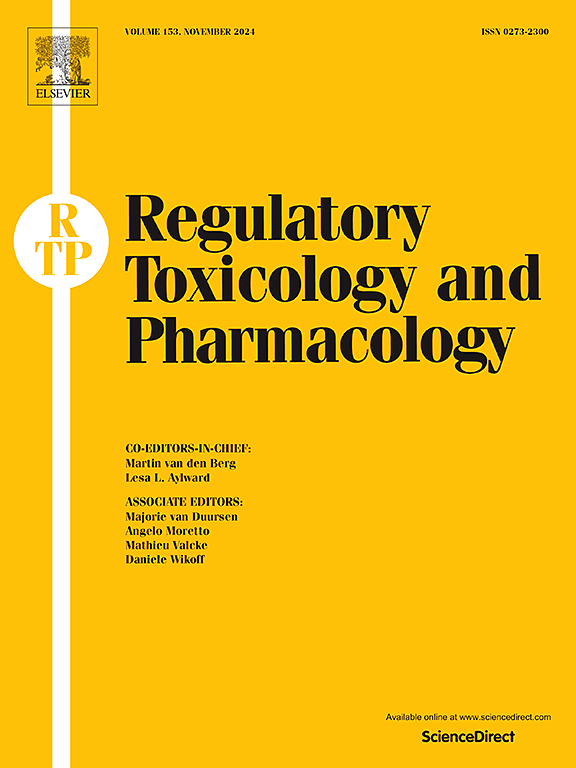Assessment of human breast milk contamination with lead, mercury, cadmium, and arsenic and associated health risks in northeastern Algeria
IF 3.5
4区 医学
Q1 MEDICINE, LEGAL
引用次数: 0
Abstract
Lead (Pb), mercury (Hg), cadmium (Cd), and arsenic (As) pose global food safety concerns, with infants being particularly vulnerable due to exposure from maternal body burden. This study assessed health risks associated with exposure to Cd, Pb, Hg and As through breast milk consumption among women residing in Guelma, northeastern Algeria. Eighty-four breast milk samples were collected and analyzed using atomic absorption spectrometry, following microwave-assisted acid digestion. The mean concentrations of toxic metals in breast milk were as follows: Pb (15.77 ± 9.54 μg/L) > Hg (3.26 ± 2.50 μg/L) > Cd (2.75 ± 2.39 μg/L) > As (0.35 ± 0.73 μg/L). The Target Hazard Quotient (THQ) for Hg exceeded the safety threshold of 1 across all age groups, with 83 %, 82 %, and 49 % of samples surpassing this limit for 1-month, 6-month, and 12-month-old infants, respectively. Similarly, the Hazard Index (HI) exceeded 1 in all age groups, indicating significant non-carcinogenic risks. Furthermore, the Total Carcinogenic Risk (TCR) for all metals surpassed the acceptable limit (TCR = 1 × 10−4), with Cd posing a particularly high risk, as 82 % of samples exceeded the carcinogenic threshold. These findings highlight both carcinogenic and non-carcinogenic risks from infant exposure to toxic metals via breast milk, underscoring the urgent need for nationwide monitoring programs, stricter industrial emission controls, and further research into maternal dietary exposure.
阿尔及利亚东北部人类母乳铅、汞、镉和砷污染及相关健康风险评估
铅(Pb)、汞(Hg)、镉(Cd)和砷(As)构成了全球食品安全问题,由于母亲的身体负担,婴儿尤其容易受到影响。本研究评估了居住在阿尔及利亚东北部Guelma的妇女通过母乳摄入接触Cd、Pb、Hg和As的相关健康风险。采用原子吸收光谱法对84份母乳样品进行微波辅助酸消化分析。母乳中有毒金属的平均浓度为:Pb(15.77±9.54 μg/L) >;Hg(3.26±2.50 μg/L) >;Cd(2.75±2.39 μg/L) >;为(0.35±0.73 μg/L)。在所有年龄组中,汞的目标危害商(THQ)均超过安全阈值1,1个月、6个月和12个月婴儿中分别有83%、82%和49%的样本超过该限值。同样,所有年龄组的危害指数(HI)均超过1,表明存在显著的非致癌风险。此外,所有金属的总致癌风险(TCR)都超过了可接受限度(TCR = 1 × 10−4),其中镉的风险特别高,82%的样品超过了致癌阈值。这些发现强调了婴儿通过母乳接触有毒金属的致癌和非致癌风险,强调了迫切需要在全国范围内开展监测计划,更严格的工业排放控制,并进一步研究母亲的饮食暴露。
本文章由计算机程序翻译,如有差异,请以英文原文为准。
求助全文
约1分钟内获得全文
求助全文
来源期刊
CiteScore
6.70
自引率
8.80%
发文量
147
审稿时长
58 days
期刊介绍:
Regulatory Toxicology and Pharmacology publishes peer reviewed articles that involve the generation, evaluation, and interpretation of experimental animal and human data that are of direct importance and relevance for regulatory authorities with respect to toxicological and pharmacological regulations in society. All peer-reviewed articles that are published should be devoted to improve the protection of human health and environment. Reviews and discussions are welcomed that address legal and/or regulatory decisions with respect to risk assessment and management of toxicological and pharmacological compounds on a scientific basis. It addresses an international readership of scientists, risk assessors and managers, and other professionals active in the field of human and environmental health.
Types of peer-reviewed articles published:
-Original research articles of relevance for regulatory aspects covering aspects including, but not limited to:
1.Factors influencing human sensitivity
2.Exposure science related to risk assessment
3.Alternative toxicological test methods
4.Frameworks for evaluation and integration of data in regulatory evaluations
5.Harmonization across regulatory agencies
6.Read-across methods and evaluations
-Contemporary Reviews on policy related Research issues
-Letters to the Editor
-Guest Editorials (by Invitation)

 求助内容:
求助内容: 应助结果提醒方式:
应助结果提醒方式:


